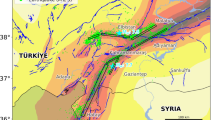Abstract
Perturbations of the vertical component of an electric field of seismogenic origin near the Earth’s surface prior to some earthquakes are modeled analytically based on data from measurements in the surface layer of the atmosphere at midlatitudes, and the field’s magnitude at the ionospheric level is calculated with allowance for the inclination of geomagnetic lines of force. An analytical approximation of the seismogenic perturbation of the vertical component of the electric field on the Earth’s surface is obtained. The approximation adequately describes the data from those measurements. It is shown that, ~3.5 h before the earthquake on March 20, 2008, in the border region of the Chinese provinces of Xinjiang and Xizang, which had a with a magnitude of M = 7.2, the detection of a quasi-static electric field with a seismogenic nature and a magnitude of 0.44 to 0.88 mV/m can be hypothetically expected over the epicentral area in the ionosphere; the field is perpendicular to magnetic field lines.









Similar content being viewed by others
REFERENCES
Ampferer, M., Denisenko, V.V., Hausleitner, W., Krauss, S., Stangl, G., Boudjada, M.Y., and Biernat, H.K., Decrease of the electric field penetration into the ionosphere due to low conductivity at the near ground atmospheric layer, Ann. Geophys., 2010, vol. 28, no. 3, pp. 779–787.
Baumgaertner, A.J.G., Thayer, J.P., Neely, R.R., and Lucas, G., Toward a comprehensive global electric circuit model: Atmospheric conductivity and its variability in CESM1 (WACCM) model simulations, J. Geophys. Res.: Atmos., 2013, vol. 118, pp. 9221–9232. https://doi.org/10.1002/jgrd.50725
Choudhury, A., Guha, A., De, B.K., and Roy, R., A statistical study on precursory effects of earthquakes observed through the atmospheric vertical electric field in northeast India, Ann. Geophys., 2013, vol. 56, no. 3, R0331. https://doi.org/10.4401/ag-6235
Cole, Jr., R.K. and Pierce, E.T., Electrification in the Earth’s atmosphere for altitudes between 0 and 100 kilometers, J. Geophys. Res., 1965, vol. 70, no. 12, pp. 2735–2749. https://doi.org/10.1029/JZ070i012p02735
Denisenko, V.V., Boudjada, M.Y., Horn, M., Pomozov, E.V., Biernat, H.K., Schwingenschuh, K., Lammer, H., Prattes, G., and Cristea, E., Ionospheric conductivity effects on electrostatic field penetration into the ionosphere, Nat. Hazards Earth Syst. Sci., 2008, vol. 8, no. 5, pp. 1009–1017. https://doi.org/10.5194/nhess-8-1009-2008
Denisenko, V.V., Ampferer, M., Pomozov, E.V., Kitaev, A.V., Hausleitner, W., Stangl, G., and Biernat, H.K., On electric field penetration from ground into the ionosphere, J. Atmos. Sol.-Terr. Phys., 2013, vol. 102, pp. 341–353. https://doi.org/10.1016/j.jastp.2013.05.019
Denisenko, V.V., Nesterov, S.A., Boudjada, M.Y., and Lammere, H., A mathematical model of quasistationary electric field penetration from ground to the ionosphere with inclined magnetic field, J. Atmos. Sol.-Terr. Phys., 2018, vol. 179, pp. 527–537. https://doi.org/10.1016/j.jastp.2018.09.002
Dobrovolsky, I.R., Zubkov, S.I., and Myachkin, V.I., Estimation of the size of earthquake preparation zones, Pure Appl. Geophys., 1979, vol. 117, no. 5, pp. 1025–1044.
Hao, J., Tang, T.M., and Li, D.R., Progress in the research of atmospheric electric field anomaly as an index for short-impending prediction of earthquakes, J. Earthquake Predict. Res., 2000, vol. 8, no. 3, pp. 241–255.
Hegai, V.V., Kim, V.P., and Liu, J.Y., On a possible seismo–magnetic effect in the topside ionosphere, Adv. Space Res., 2015, vol. 56, no. 8, pp. 1707–1713. https://doi.org/10.1016/j.asr.2015.07.034
Hegai, V.V., On the correlation between strong earthquakes and solar activity level in cycles 21, 22, and 23, in Astronomiya-2018 (Astronomy-2018), vol. 2: Solnechno–zemnaya fizika—sovremennoe sostoyanie i perspektivy (Solar–Terrestrial Physics: Current State and Prospects), Obridko, V.N., Ed., Moscow: Trovant, 2018, pp. 262–265. https://doi.org/10.31361/eaas.2018-2.066
https://ccmc.gsfc.nasa.gov/modelweb/models/iri2016_vitmo.php
https://earthquake.usgs.gov/earthquakes/browse/significant.php?year=2010
https://modelweb.gsfc.nasa.gov/atmos/nrlmsise00.html
Huang, C.-S., Foster, J.C., and Sahai, Y., Significant depletions of the ionospheric plasma density at middle latitudes: A possible signature of equatorial spread F bubbles near the plasmapause, J. Geophys. Res., 2007, vol. 112, A05315. https://doi.org/10.1029/2007JA012307
Kim, V.P. and Hegai, V.V., On the electric fields produced by dipolar Coulomb charges of an individual thundercloud in the ionosphere, J. Astron. Space Sci., 2015, vol. 32, no. 2, pp. 141–144. https://doi.org/10.5140/JASS.2015.32.2.141
Liu, J.-Y. and Chao, C.K., An observing system simulation experiment for FORMOSAT-5/AIP detecting seismo-ionospheric precursors, Terr. Atmos. Ocean Sci., 2017, vol. 28, no. 2, pp. 117–127. https://doi.org/10.3319/TAO.2016.07.18.01(EOF5)
Park, C.G. and Dejnakarintra, M., Penetration of thundercloud electric fields into the ionosphere and magnetosphere: 1. Middle and subauroral latitudes, J. Geophys. Res., 1973, vol. 78, no. 28, pp. 6623–6633. https://doi.org/10.1029/JA078i028p06623
Park, C.G. and Dejnakarintra, M., Thundercloud electric fields in the ionosphere, in Electrical Processes in Atmospheres, Dolezalek, H., Reiter, R., Landsberg, H.E., Eds., Darmstadt: Dr. Dietrich Steinkopff, 1976, pp. 544–551. https://doi.org/10.1007/978-3-642-85294-7_84
Pulinets, S.A. and Boyarchuk, K.A., Ionospheric Precursors of Earthquakes, Berlin: Springer, 2004.
Rycroft, M.J., Odzimek, A., Arnold, N.F., Füllekrug, M., Kułak, A., and Neubert, T., New model simulations of the global atmospheric electric circuit driven by thunderstorms and electrified shower clouds: The roles of lightning and sprites, J. Atmos. Sol.-Terr. Phys., 2007, vol. 69, nos. 17–18, pp. 2485–2509. https://doi.org/10.1016/j.jastp.2007.09.004
Schunk, R.W., A mathematical model of the middle and high latitude ionosphere, Pure Appl. Geophys., 1988, vol. 127, nos. 2–3, pp. 255–303.
Author information
Authors and Affiliations
Corresponding author
Additional information
Translated by A. Nikol’skii
Rights and permissions
About this article
Cite this article
Khegai, V.V. Analytical Model of a Seismogenic Electric Field According to Data of Measurements in the Surface Layer of the Midlatitude Atmosphere and Calculation of Its Magnitude at the Ionospheric Level. Geomagn. Aeron. 60, 507–520 (2020). https://doi.org/10.1134/S0016793220030081
Received:
Revised:
Accepted:
Published:
Issue Date:
DOI: https://doi.org/10.1134/S0016793220030081




